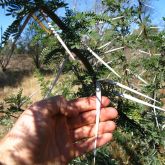Karroo thorn
Alert
Be on the lookout for Karroo thorn.
Report sightings
- Report online
- Contact us online, by phone or in person
- Call Biosecurity Queensland on 13 25 23.

Karroo thorn spike
© Queensland Government

Acacia karroo close up of flowers
© Jennifer Gardner

Acacia karroo flowers
© Jennifer Gardner

Karroo thorn pods
© Jennifer Gardner

Karroo thorn plant form
© Queensland Government

Karroo thorn
© Queensland Government

Karroo thorns
© Jennifer Gardner
Native to southern Africa, Karroo thorn is a fast-growing shrub or tree. It could become a serious invasive plant in Queensland, with the potential to reduce agricultural productivity by suppressing the growth of grasses.
Scientific name
Other names
- Sweet-thorn, cockspur thorn, Cape gum, mimosa thorn
Similar species
- Prickly acacia
- Mimosa bush
- Kangaroo thorn
Description
- Shrub or tree up to 12m tall.
- Thorns are white, paired, up to 10cm long.
- Flowers are yellow, ball-shaped, in clusters of 4–6, 1–1.5cm in diameter.
- Bark is rough, red-brown to black.
- Leaves are light-green, fern-like, up to 12cm long, 5cm wide.
- Leaflets are 3.5–8mm by 1–3mm.
- Seed pods are sickle-shaped, woody, slightly constricted between seeds, up to 16cm long, 1cm wide.
Habitat
- Prefers range of soil types, generally in areas of rangelands in subcoastal, semi-arid and arid southern Queensland.
- Drought-tolerant due to extensive root system.
Distribution
- Detections recorded on the Darling Downs and in Rockhampton.
- Visit Weeds Australia and click on the distribution tab to access the distribution map.
Life cycle
- Reproduces by seed; large trees produce up to 19,000 seeds per year.
- Seeds can lie in soil for 7 years and still germinate.
- Flowering occurs mostly during summer.
Affected animals
- Livestock
- Cattle
Impacts
Environmental
- Invades large areas, particularly where land has been overgrazed.
- Resists fire and is well-suited to rangelands and open grasslands.
Economic
- Reduces agricultural productivity by suppressing grass growth.
- Prevents stock movement and can restrict watering.
How it is spread
- Seeds spread by wind and water or in droppings of animals.
Prevention
Control
- Before undertaking any preventative or control actions, contact our Customer Service Centre.
Legal requirements
- Karroo thorn is a prohibited invasive plant under the Biosecurity Act 2014.
- You must not keep, move, give away, sell or release into the environment. Penalties may apply.
- You must not take any action reasonably likely to exacerbate the biosecurity threat posed by Karroo thorn.
- You must take any action that is reasonably likely to minimise the biosecurity threat posed by Karroo thorn.
- You must report all sightings to Biosecurity Queensland within 24 hours.